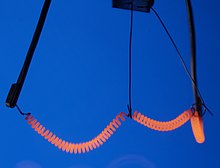Joule heating
The law of heat of electricity (also called James Prescott Joule's first law or Joule-Lenz law after Joule and Emil Lenz) states that an electric current in an electrical conductor produces the heat energy 

with the electrical power 

The cause of heating when current flows is described in Electrical resistance#The electrical resistance in the particle model.
The terms joule heat and power heat are not used consistently, partly in the sense of energy, partly of power.
Heat of current in an electric line
Preferably, a current is conducted in an electrical line. In connection with heat generation, the electrical power is always an active power. It results from the existing current 

Since the voltage is due to the ohmic resistance of 
Thus, the heating (e.g. in an electric line, a transformer or a heating resistor) increases with the square of the current strength
If the generation of the heat is desired, the heat is called electric heat, otherwise it is called current heat loss or ohmic loss.
The heat energy primarily leads to a heating of the conductor by a temperature difference of
with the heat capacity 

As the conductor becomes warmer than its surroundings, it transfers heat energy by conduction, radiation or convection. If the energy supply is continuously uniform, a state of equilibrium is established at an elevated temperature in which the heat flux given off 
With a surface involved in the heat transport 
In general, bodies have such a thermal inertia that the temperature difference is a constant at stationary current, even when heated by alternating current. Only in the case of a very small ratio of mass to surface, as in the case of the double helix shown, can a temperature or brightness fluctuation with twice the frequency of the alternating current be observed by metrological means.

Double helix heated to red heat as a result of a current flow
Heat of current in electric flow field
If a current flows through a conductive substance distributed over a larger volume, then 

on whose path along a path element 
drops off, generating heat. In it, stands 




The loss of electric power results in the volume element 

Metallic conductors exhibit electrical resistivity that is largely independent of current (but temperature dependent). In semiconductors, ρ is 

The total current heat loss in a current-carrying conductor is generally calculated from the volume integral

If ρ is 
leads. In the case of more complicated geometric design with non-uniform current distribution, this must be calculated, e.g. using the finite element method, in order to be able to determine the power loss and the macroscopic resistance of the conductor.
In materials with non-constant resistivity, a current-dependent resistance can be 

Questions and Answers
Q: What are Joule's laws?
A: Joule's laws are two physical laws that describe the relation between heat generated by an electric current and how the energy of a gas relates to pressure and volume.
Q: What is Joule's first law?
A: Joule's first law shows the relation between heat generated by an electric current flowing through a conductor. It is shown as Q = I2Rt, where Q is the amount of heat, I is the electric current flowing through a conductor, R is the amount of electric resistance present in the conductor, and t is the amount of time that this happens for.
Q: What does Joule's second law say?
A: Joule's second law says that the internal energy of an ideal gas does not change if volume and pressure change, but does change if temperature changes.
Q: Who was James Prescott Joule?
A: James Prescott Joule was a physicist who developed both of these laws related to thermodynamics. His work on these two laws led to his name being associated with them.
Q: Why is it important to know about Joule's laws?
A: Knowing about Joule's laws helps us understand how energy works in different systems such as electrical circuits or gases under different conditions such as pressure or temperature changes. This understanding can help us design better systems for generating or using energy more efficiently.
Q: How can we calculate heat produced by an electric current according to Joules' first law?
A: According to Joulse' first law, we can calculate heat produced by an electric current using this equation - Q = I2Rt , where Q is the amount of heat, I is the electric current flowing through a conductor, R is the amount of electric resistance present in the conductor, and t is the amount of time that this happens for.
Search within the encyclopedia










